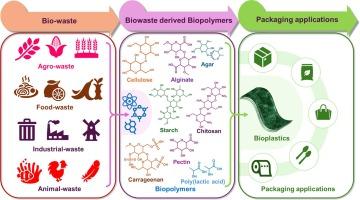Ecofriendly bioplastics from biowaste: Antimicrobial and functional enhancements for sustainable packaging
IF 5.8
2区 化学
Q1 POLYMER SCIENCE
引用次数: 0
Abstract
Food waste exacerbates greenhouse gas emissions and environmental degradation, while the prevalent use of conventional plastics in food packaging, characterized by their cost-efficiency, lightweight nature, and durability, has intensified environmental concerns through increased greenhouse gas emissions and waste accumulation. In response, the utilization of biowaste-derived biopolymers for bioplastic production has emerged as a promising strategy within the framework of the circular economy. Although these bioplastics offer advantages such as biodegradability and bio-based origins, early formulations were constrained by suboptimal mechanical strength, hydrophilicity, and barrier properties, necessitating the incorporation of advanced additives. Recent advancements have centred on improving the functionality of bioplastics derived from biowaste through the integration of specialized additives. These enhancements, including the incorporation of functional fillers and reinforcement agents, have significantly augmented the tensile strength, Young’s modulus, thermal stability, and water vapor barrier performance of bioplastics. Additionally, these additives impart notable antimicrobial and antioxidant properties, which enhance food safety and extend shelf life while maintaining eco-friendly characteristics. This review comprehensively examines the latest innovations in biowaste-to-bioplastics technologies, focusing on the integration of antimicrobial, antioxidant, and physiochemical enhancements. By highlighting these advancements, the review emphasizes the transformative potential of biowaste-derived bioplastics in developing sustainable food packaging solutions and advancing a circular economy.

从生物废弃物中提取生态友好型生物塑料:用于可持续包装的抗菌剂和功能增强剂
食品废弃物加剧了温室气体排放和环境退化,而食品包装中普遍使用的传统塑料具有成本效益高、重量轻和耐用的特点,但却增加了温室气体排放和废弃物积累,从而加剧了对环境的担忧。为此,在循环经济的框架下,利用生物废弃物衍生的生物聚合物生产生物塑料已成为一项前景广阔的战略。虽然这些生物塑料具有生物可降解性和生物基来源等优势,但早期的配方受到机械强度、亲水性和阻隔性能不理想的限制,因此必须加入先进的添加剂。最近的进展主要集中在通过添加特殊添加剂来提高从生物废弃物中提取的生物塑料的功能性。这些改进包括加入功能性填料和增强剂,大大提高了生物塑料的拉伸强度、杨氏模量、热稳定性和水蒸气阻隔性能。此外,这些添加剂还具有显著的抗菌和抗氧化性能,可提高食品安全性,延长保质期,同时保持环保特性。本综述全面探讨了生物废弃物转化为生物塑料技术的最新创新,重点关注抗菌、抗氧化和理化增强功能的整合。通过重点介绍这些先进技术,综述强调了生物废弃物衍生生物塑料在开发可持续食品包装解决方案和推进循环经济方面的变革潜力。
本文章由计算机程序翻译,如有差异,请以英文原文为准。
求助全文
约1分钟内获得全文
求助全文
来源期刊

European Polymer Journal
化学-高分子科学
CiteScore
9.90
自引率
10.00%
发文量
691
审稿时长
23 days
期刊介绍:
European Polymer Journal is dedicated to publishing work on fundamental and applied polymer chemistry and macromolecular materials. The journal covers all aspects of polymer synthesis, including polymerization mechanisms and chemical functional transformations, with a focus on novel polymers and the relationships between molecular structure and polymer properties. In addition, we welcome submissions on bio-based or renewable polymers, stimuli-responsive systems and polymer bio-hybrids. European Polymer Journal also publishes research on the biomedical application of polymers, including drug delivery and regenerative medicine. The main scope is covered but not limited to the following core research areas:
Polymer synthesis and functionalization
• Novel synthetic routes for polymerization, functional modification, controlled/living polymerization and precision polymers.
Stimuli-responsive polymers
• Including shape memory and self-healing polymers.
Supramolecular polymers and self-assembly
• Molecular recognition and higher order polymer structures.
Renewable and sustainable polymers
• Bio-based, biodegradable and anti-microbial polymers and polymeric bio-nanocomposites.
Polymers at interfaces and surfaces
• Chemistry and engineering of surfaces with biological relevance, including patterning, antifouling polymers and polymers for membrane applications.
Biomedical applications and nanomedicine
• Polymers for regenerative medicine, drug delivery molecular release and gene therapy
The scope of European Polymer Journal no longer includes Polymer Physics.
 求助内容:
求助内容: 应助结果提醒方式:
应助结果提醒方式:


